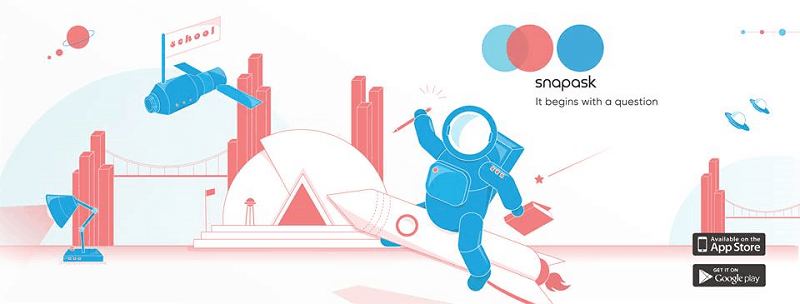Stop procrastinating, Snapask before you Snapchat
Growing up in Singapore, we’ve all either had private tuition after school ourselves or sought help through YouTube to resolve our academic issues from time to time. Singapore’s tuition industry is famously known to be valued over a billion dollars annually, supported by parents who spend hundreds to thousands of dollars on tuition every month.
Snapask is an app-based service that helps individuals get instant academic support from verified top tier tutors. As its name suggests, all you must do is to snap a photo of the question, explain the sort of challenges that you are facing and before you can say “SNAPASK”, tutors from local universities such as NTU, NUS and SMU will start a private tutoring session with you through Snapask’s in-app messaging platform.
The conception of Snapask came when co-founder Timothy Yu first started a brick-and-mortar tuition centre in Hong Kong, where sky-high rental costs and slow business growth weighed down on the company’s profitability.
As what many entrepreneurs in the digital era would do next, Timothy took his store-front business online, joined by his former Hong Kong University classmates Phoebe Huang and Bradley Chiang.
Snapask was launched in Hong Kong in January 2015, and has attained sufficient success to expand their operations into Singapore, Taiwan and Shanghai. According to Timothy, Snapask has approximately 20,000 active users and 1,500 new registered users daily.
Having expanded its tutoring operations across various countries, Snapask even managed to further diversify their range of products and services to accommodate schools as well. Introducing Snapask Class; a multimedia teaching assistant.
Snapask Class’s primary objective is to provide teachers with a platform to organize weekly challenges for their students. With Snapask Class, teachers can post questions on Snapask’s web-based platform, where students can ask and answer the respective questions on Snapask’s mobile application.
Of course, in a world of in-app purchases, premiums atop of premiums, it is no surprise that a service like Snapask is not completely free. Snapask charges US$1.29 for every question asked, and US$38.60 for a bundle of 50 questions to be used sparingly. Tutors receive US$0.51 for every question they answer, and can possibly become a “Premium Tutor”, thereafter earning a bonus of US$6.43 for every 10 answered questions. As per Snapask class, schools are given a free trial period to experience Snapask’s services before paying for a customized package priced according to the school’s needs.
I’m sure that by now, you’re already wondering about how can Snapask possibly succeed in an overly-saturated education market in Singapore? So am I. But whichever the case, it is worth noting that Snapask is doing exceptionally well in Hong Kong; a country that we share the most socio-economic similarities with, where Snapask raised over HK$13.5 million in a pre-A round of funding in August 2015.
Speaking from a local university undergraduate’s perspective, Snapask’s attractiveness comes in the flexibility it provides to university students in terms of earning an alternative income. For many Generation Y (and the upcoming Generation 2020) university students like myself, work-life balance is paramount in anything we do and we worship the freedom of choice religiously. That said, for students trying to earn a quick buck, Snapask might just be the answer (apart from writing articles )
I believe that many of us, students, or had-been students in Singapore’s education system, will agree that many of our teachers have went through considerable lengths to try to make learning as engaging as possible for us.
Excursions, Visits to the computer labs, and even unofficial school holidays such as E-learning day are all attempts at making learning fun for students.However, precisely because of the magnitude of Singapore’s billion dollar industry, it is going to be difficult to motivate students and most importantly their parents, to make such a drastic change towards how their children are learning.
The education system in Singapore is more than just routine in the world of academics, but in fact, it holds a massive cultural significance to how Singaporean parents discipline their children.
Similar to the culture of Hagwon in Korea and Cram schools in Japan, private-tuition in Singapore, be it at the tuition centre or at home, involves a physical interaction with the tutor. In an era of shared-information and knowledge, parents are aware of the consequences of their child taking shortcuts just to solve their problems, despite primarily being results-oriented.
Taking away the need for physical communication through seeking explanations to questions might cause parents to fear for their children’s development in soft-skills, towards communicating well with others and being inquisitively eloquent. What’s more, in a culture where parents shove tablets and phones to their children to resolve their tantrum tendencies and child-like boredom, the importance of being able to communicate and interact well with others physically has never been more paramount in an increasingly business-centric world.
Besides, if Snapask is primarily providing a service which focuses on on-demand assistance beyond the periphery of Singapore’s existing private and public education system, they will be competing against well-established rivals such as WolframAlpha; a computational knowledge engine that gives its users access to the world’s facts and data. WolframAlpha is able to answer queries based on computational facts, ranging from “what is the integration of 2x – 3?” to “what is the circumference of the moon divided by 8?” for FREE.
Realistically speaking, if one is unable to solve a problem at home, the typical student nowadays would seek help from their friends and private tutors through Whatsapp Groups, Study sessions at Changi Airport or simply clarify their doubts during class or after-class consultations with their teachers.
Despite these obstacles posed to Snapask in Singapore, it is comforting to recognize that parents these days are more open to alternative forms of learning, as long as it gives their child a comparative edge over their peers. In an increasingly competitive society, many parents are more than willing to work tirelessly through multiple jobs to afford an extensive education for their children, in hopes of seeing their children achieve career success one day.
In a fast-paced culture that values convenience and efficiency, I believe that parents would almost without a hesitation, subscribe their children to Snapask.
That said, the next time someone asks me for a solution to a problem sum, I’ll probably ask him whether he would prefer a monthly bundle of 50 questions instead.




















